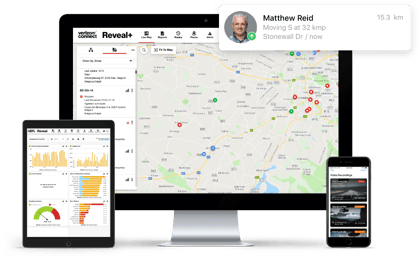Build your advanced fleet safety programme
Develop an advanced fleet safety programme to improve driver behaviour, reduce accidents, and enhance overall safety...
Read more
Daytime running lights or DRLs are low-intensity lights that improve vehicle visibility on the road by increasing the contrast between vehicles and the environment.
While some research shows DRLs could improve road safety, reducing everything from pedestrian accidents to head-on collisions. In “European Union countries, all cars and vans manufactured after 2011 must come equipped with daytime running lights. (1). Trucks and buses “followed in August 2012. Vehicles produced before don't have to be retrofitted” (2).
This article will look at what DRLs are, how they differ from regular headlights, their benefits, where they are mandated and how they impact fleet safety.
DRLs are low-intensity lights on the front of vehicles that automatically turn on when a vehicle’s engine is started.
The European Commission explains that “daytime running lights (DRLs) come on automatically whenever a vehicle's engine is started. They substantially increase the visibility of cars and other vehicles and they “consume just 25-30% of the energy needed to power a conventional dipped headlight” (3) and the benefits for safety are really relevant to mitigate the risk of accidents.
While DRLs are a safety feature that typically cannot be turned off, particularly while the vehicle is in motion, some manufacturers offer a DRL off switch that allows the driver to turn them off.
The primary benefit of DRLs is simple: increased contrast and visibility lead to fewer collisions, particularly for vehicles that are less noticeable during daylight, or when certain daytime weather conditions like glaring sun or cloudy skies impair visibility.
Studies have shown that DRLs can reduce the risk of accidents involving other vehicles, pedestrians, cyclists and motorcyclists.
According to a study by the Institute for Road Safety Research, “in-depth crash studies have shown that not having seen the other road user or having seen the other road user too late plays a role in 50% of the daytime crashes, and for intersection crashes this is even 80%” (4).
In depth, Meta-analyses of the effects of DRL use in cars show that DRL contributes substantially to reducing road crashes, car occupant and vulnerable road user injuries whatever the country's latitude (5).
Further to this, “a reduction in multi-party crashes of between 8%-15% was found as a result of introducing mandatory laws on daytime use. A compilation of Norwegian meta-analysis of 25 studies that have evaluated DRL for cars and 16 studies that have evaluated DRL for motorcycles “found that DRL reduces the number of multi-party daytime crashes by 5-10 per cent” (6).
Furthermore, a Dutch review found “that DRL reduced multi-party daytime crashes by around 12% and deaths and injured victims by 25% and 20%
So, in summary, the use of DRLs can help increase the safety of drivers and is very relevant to an organisation's safety policy.
Find out how fleet management software is shaping fleet safety programmes, reducing accident costs and improving maintenance.
Fleet managers looking for other ways to help boost fleet safety may want to consider a fleet management solution that empowers them to develop and maintain effective safety programmes. Fleet management can help impact safety in several different ways:
Sources:
Tags: Safety




Find out how our platform gives you the visibility you need to get more done.
Develop an advanced fleet safety programme to improve driver behaviour, reduce accidents, and enhance overall safety...
Read moreWe surveyed more than 200 fleet managers in Ireland to learn more about the trends and insights within the fleet management...
Read moreUsing Vision Zero in your fleet safety programme can help reduce road fatalities and serious injuries. Find out how.
Read moreHere are four ways to focus on fleet safety, including new video-based driver coaching features from Verizon Connect.
Read more